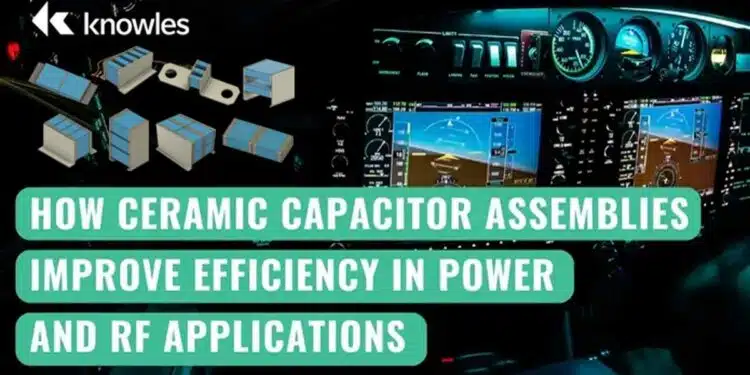This article based on Knowles Precision Devices blog explains how stacked ceramic capacitor assemblies improve efficiency in power and RF applications.
By utilizing stacked configurations and advanced dielectric materials, capacitor assemblies optimize performance in power conversion and radio frequency (RF) signal management.
These assemblies are designed to meet the demands of power electronics and radio frequency applications, where stability, efficiency, and compact design are important design considerations.
Ceramic Capacitor Assembly Applications
Power electronics and RF systems present particularly demanding environments that benefit from the enhanced performance of ceramic capacitor assemblies over assemblies with traditional aluminum capacitors and tantalum capacitors. Here, we explore both application areas.
Ceramic Capacitor Assemblies in Power Electronics
In power electronic circuits, capacitor assemblies are integral for filtering high-frequency noise, voltage smoothing, and energy storage. Applications like switch-mode power supplies (SMPS), buck and boost converters, DC-AC inverters, and DC-DC converters rely on these assemblies for improved efficiency and performance.
In power electronics, capacitor assemblies support:
- Filtering and Voltage Smoothing: Capacitor assemblies help reduce ripple and transient voltage fluctuations in AC-DC conversion circuits, ensuring stable power delivery.
- High Capacitance Density: Stacking X7R capacitors enables higher capacitance density, while minimizing PCB footprint.
- Bulk Decoupling: Compared to individual MLCCs placed near high-speed ICs, capacitor assemblies provide robust bulk decoupling at the output of power converters to maintain steady voltage levels.
Knowles’ capacitor assemblies leverage vertical stacking techniques to provide higher capacitance-to-volume ratios than traditional electrolytic capacitors. The balance between size and performance makes them beneficial in power-dense applications like avionics and electric vehicles.
Ceramic Capacitor Assemblies in RF Circuits
RF circuits in high-frequency applications require capacitors with low equivalent series resistance (ESR) and equivalent series inductance (ESL) to ensure minimal signal loss and high efficiency. Capacitor assemblies are widely used in RF power amplifiers, voltage-controlled oscillators, impedance matching networks, and plasma/RF heating systems.
Here, capacitor assemblies support:
- Low Loss and High Stability: Capacitors with Class I dielectrics, such as C0G/NP0, offer minimal variation in capacitance over temperature and frequency, ensuring consistent RF performance.
- Impedance Matching: Capacitor assemblies facilitate the precise tuning of impedance networks to optimize power transfer between RF components like antennas and transmission lines.
- High Q Factor: With low ESR, capacitor assemblies enhance circuit resonance, minimizing signal distortion and energy loss in RF amplifiers and oscillators.
Beyond RF amplifier and oscillator applications, ceramic capacitor assemblies are useful in network infrastructure, mission-critical communications devices, and other environments that call for stable, high-frequency electronic performance. By incorporating advanced materials and precise stacking techniques, Knowles’ capacitor assemblies deliver the high Q performance needed while prioritizing stability, power handling, and volumetric efficiency.
Optimized Performance for Critical Applications
Whether in power electronics or RF systems, Knowles capacitor assemblies provide a high-capacitance, low-loss solution that improves performance while optimizing board space.
Additionally, Knowles offers customization options for capacitor assemblies tailored to specific voltage, capacitance, and reliability requirements. As a MIL-qualified facility, we offer solutions for mission-critical applications for long-term reliability and failure prevention too.
For more information on Knowles’ capacitor assemblies and how they can improve your designs, review our Capacitor Assemblies Catalog.
































